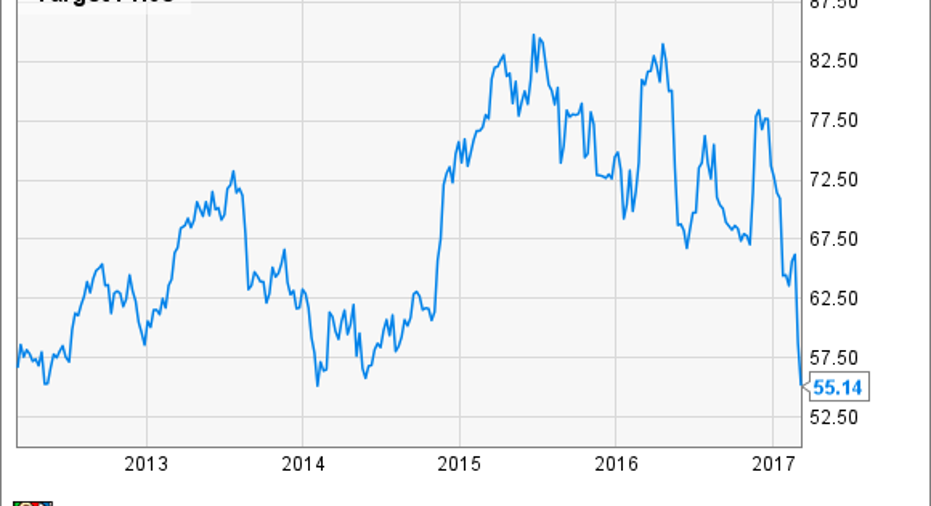Here Are the Keys to Target's Turnaround

Target (NYSE: TGT) has been pummeled after reporting disappointing 2016 holiday sales and forecasting falling profits in the year ahead. The big-box store is battling a tough retail environment brought on by falling foot traffic as an increasing number of shoppers opt for an online experience.
Data by YCharts.
Recent investor pessimism was sparked partly by fourth-quarter numbers that showed a fall in revenue and comparable sales, which declined 4.3% and 1.5%, respectively. The other reason for worry coming out of the fourth-quarter report was that management said 2017 earnings per share will come in between $3.80 and $4.20, a 15% decrease at the midpoint from 2016.
The reason for the expected drop in the bottom line? Target plans to spend $1 billion in 2017 out of its operating profits to adapt its business model to changing shopper preferences. Over the next three years, a total of $7 billion in investment is planned. It's ambitious, and investors are obviously nervous about it, but Target is ready to fight back against declines in sales.
Target's history of innovation
Target is no stranger to changing consumer shopping preferences. In the early 1900s, Target, then known as Dayton's after the family that owned it, was a regional department store in the Midwest.
By the 1960s, the Dayton's department store chain was doing well in its home state of Minnesota. Times were changing, though, and big-box discount retailers like Wal-Mart were just beginning to pop up around the country. The Daytons decided to jump in the game and launch a new type of discount chain, one that combined department store qualities with the value slant that many shoppers were looking for. The new format was named Target.
A Dayton's Department Store in the 1950s. Image source: Target.
Times are changing again, but this time, physical stores in general are under attack from more convenient online competition like Amazon.com. Target was an early adopter of online shopping and launched its own digitally formatted store back in 1999, but sales from it have remained a very small part of the overall business.
The problem and the solution
However, it's worth noting that, since 2013, Target has doubled sales from the internet. In the last reported quarter, online sales increased 34% from the previous year, with digital sales making up 6.8% of sales. However, the problem has been that the move to online hasn't been able to outpace declines in foot traffic.
To stop the bleeding, Target's upcoming spending spree is aimed at adapting business to what the consumers now want, including a streamlined digital shopping experience, exclusive brands, competitive prices, and faster delivery. The merchandiser will continue to enhance its online experience, but its existing stores will also play an important role in digital strategy.
For starters, by 2019, all physical locations will serve the secondary purpose of distribution center. When customers shop online, their order will be delivered from their nearest Target location. That helps delivery times, but also helps the company operate more efficiently.
Target has also been experimenting with smaller-format stores in urban areas and on college campuses. Thirty more are planned to cut ribbons this year, doubling the company's reach with the small format. Other features that will be available this year will include the ability for Target associates to search inventory, place orders, and arrange delivery of merchandise for guests who can't find what they're looking for in-store.
Image source: Target.
The final area of work will involve the launch of 12 new exclusive brands, an area that has been successful in the past. Over the last year, Target has reported positive sales growth from its exclusive line-ups even while overall sales have struggled. Look for more information in the months ahead on what these new brands will be.
Can Target pull it off?
Target will be attempting a comeback in a crowd of other traditional retailers all trying to navigate the move to a digital-first shopping experience. It will be a difficult task since Amazon already has a substantial lead in the online selling world. Even in the midst of a tough year, though, Target has managed to increase its free cash flow, or money left over after operating expenses are paid for.
Data by YCharts.
That spare change will play an important role in the years ahead. Investors can expect to see this metric drop as the company puts some of it to work executing its new plans. Ultimately, the real test will be if sacrificing profitability can help grow top-line sales.
10 stocks we like better than TargetWhen investing geniuses David and Tom Gardner have a stock tip, it can pay to listen. After all, the newsletter they have run for over a decade, Motley Fool Stock Advisor, has tripled the market.*
David and Tom just revealed what they believe are the 10 best stocks for investors to buy right now...and Target wasn't one of them! That's right -- they think these 10 stocks are even better buys.
Click here to learn about these picks!
*Stock Advisor returns as of February 6, 2017.
Nicholas Rossolillo owns shares of Target. The Motley Fool has no position in any of the stocks mentioned. The Motley Fool has a disclosure policy.



















